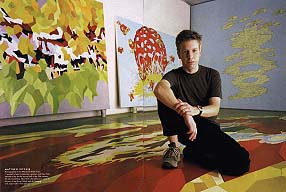|
|
|
 |
|
|
Arts
& Entertainment > Visual Arts |
|
The museums and monuments that line the National Mall in Washington D.C. house an enormous collection of art and artifacts that document both the past and present of American art and society. The National Gallery of Art Sculpture Garden, the newest attraction on the National Mall, is a place to rest among shady trees, water, and modern artworks. America's
first well-known school of painting, the Hudson River school, appeared
in 1820. As with music and literature, this development was delayed
until artists perceived that the New World offered subjects unique to
itself. The Hudson River painters' directness and simplicity of vision
influenced such later artists as
Winslow Homer, who depicted rural America.
Middle-class city life found its painter in
Thomas Eakins, an uncompromising realist whose unflinching honesty
undercut the genteel preference for romantic sentimentalism. Much of
American painting and sculpture since 1900 has been a series of
revolts against tradition. "To hell with the artistic values,"
announced Robert Henri. He was the leader of what critics called the
"ash-can" school of painting, after the group's portrayals
of the squalid aspects of city life. Today artists in America tend not to restrict themselves to schools, styles, or a single medium. "American art" is no longer a simple matter of geography, national origin, or point of view. Instead, the globalization of markets, the ease of international communication, and the nomadic movement of artists from one country to another have all contributed to an art world without firm concepts of national identity. It is no longer possible to write about contemporary art in the United States as a series of formal developments or as an orderly succession of movements. Instead, art becomes a way of filtering the multifarious and contradictory information that bombards us from every direction. Free to draw from every discipline, every art tradition, and every mode of presentation, contemporary art turns out to be just as complex, provocative, and intellectually demanding as the world that has produced it. |
|||
|
|||
| Texts
are abridged from U.S. State Department IIP
publications and other U.S. government materials. |
|||
| What
kind of information materials are available?
CD: These documents are available in fulltext format on the About the USA CD-ROM. Teachers: Request a copy for classroom use. L: Selected documents are available in German as well as other languages, including Arabic, Chinese, French, Spanish, Persian and Turkish. |
DISCLAIMER
Any reference obtained from this server to a specific commercial product, process, or service does not constitute or imply an endorsement by the United States Government of the product, process, or service, or its producer or provider. The views and opinions expressed in any referenced document do not necessarily state or reflect those of the United States Government. |
 U.S. Diplomatic Mission to Germany /Public Affairs/ Information Resource Centers Updated: December 2008 |
